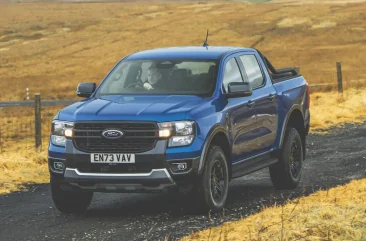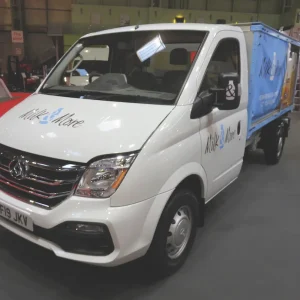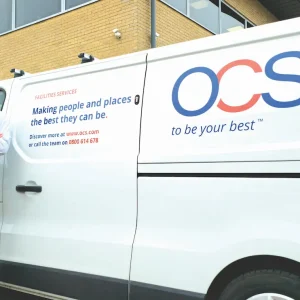
Are the good times over for the UK’s pick-up sector?
Sales of the big off roaders fell 18.9% year-on-year in October to 2,686 units, according to the Society of Motor Manufacturers and Traders (SMMT).
Over the first 10 months of 2024 the sector shrank by 3.6% with 30,719 registrations recorded. Nevertheless, the UK’s most popular pick-up, the Ford Ranger, continued to take its customary place in the list of top 10 selling LCVs; ranking fifth in October with 1,407 sales and third in the year to 31 October (16,819).
The niche 4×4 van sector, meanwhile, plummeted 62% in October to just 234 sales, which contributed to a downturn of 7.9% to 6,118 in the year-to-date.
Tax rethink
The success of the UK’s pick-up sector is based upon the favourable tax regime covering double-cab models with a payload of at least one tonne, which ensures they are classed as commercial vehicles. This has led to the appeal of top of the range ‘lifestyle’ trucks, which are used as dual-purpose work and leisure vehicles, or even just as the latter. For some time, however, the writing has been on the wall for this arrangement.
In February of this year, businesses using double-cab pick-ups were granted a reprieve when the then Conservative government, which was ousted by Labour in July’s general election, made a swift U-turn on its decision to change the tax system when it buckled under pressure from the motor industry and farmers.
An air of foreboding continued to hang over the sector though, and in the new government’s Autumn Budget at the end of October, Chancellor Rachel Reeves announced double-cab pick-ups would be taxed as company cars from April 2025, leading to a quadrupling of tariffs.
Due to the emissions-based benefit-in-kind (BIK) system, pick-up owners are set to pay the top rate of company car tax due to their high CO2 emissions levels. Passenger cars in the top band are taxed on 37% of the value. That means that buyers of a well-appointed £50,000 pick-up will be hit with a tax bill of more than £300 per month compared to the flat rate double-cab pick-up truck owners currently pay of just £65.
The one consolation for businesses is that the government has so far announced no plans to change the law allowing them to claim back VAT on pick-ups able to carry a load of at least 1,000kg.
Alternative fuels
With the clock ticking down on the internal combustion engine, some manufacturers have already began developing alternatively fuelled double-cab pick-ups. Maxus was first to market early last year with the T90 EV, which has a 1t payload but is to date only available with rear-wheel drive (RWD). A 4WD version is said to be in the pipeline but with a sub-one tonne payload.
Isuzu unveiled a fully-electric version of its D-Max pick-up truck, in prototype form in March of this year.
Badged the D-Max BEV, it features a 177hp, 4WD electric powertrain, with a 66.9kWh battery.
The model, which boasts a 1t payload and 3.5t towing capacity, is set to launch in selected mainland European markets next year, with further expansion to other countries, including the UK, said to be based on market demand and the development of EV charging infrastructure.
Isuzu UK managing director Alan Able said: “The Isuzu D-Max BEV represents a new era for pick-up trucks, combining the legendary toughness of the D-Max with electric technology.”
Isuzu is set to launch the next generation of its D-Max in January 2025. With the change in the tax law effective from April, it remains to be seen whether the brand considers it viable to launch a new double-cab diesel model in the UK. This year Isuzu has supplied 13 examples of its current D-Max, in entry-level Utility trim, to the British Airways fleet with the last four vehicles delivered in October.
Toyota is exploring the feasibility of using hydrogen fuel cells for pick-up trucks and has built 10 prototype Hilux models to test the technology. Five of these are undergoing field testing to assess safety, performance, functionality and durability, and the other five have been engaged in customer and media demonstrations, including at this summer’s Olympic and Paralympic Games in Paris.
Toyota says that know-how gained from the project will contribute to the next generation of fuel cell technology.
When asked if there were plans for a production version of the hydrogen Hilux, Toyota said its current status was that of a prototype, and details of manufacturing were outside the current scope of the project.
The hydrogen Hilux features a powertrain based on Toyota’s Mirai hydrogen car, with a driving range of up to 373 miles, and an electric motor sending 182hp to the rear wheels.
It has been developed by a consortium including Toyota Motor Manufacturing UK, Ricardo, ETL, D2H Advanced Technologies, and Thatcham Research.
Times are changing in the UK’s pick-up sector and it remains to be seen whether new, environmentally-friendly technologies can restore its position of prominence.





